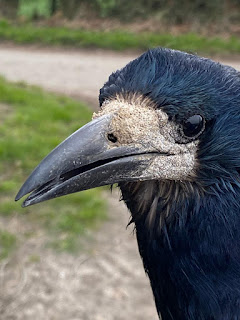This is a mantra of ours because even those of us who have been ringing for 40+ years can find new things to learn, new techniques and new skills.
So it was that Jen asked our good friend Paul if she could visit his site where there was a chance of some new species and a new skill for her to learn. Specifically, Paul has been colour ringing House Sparrows for some time now, so it was a great opportunity for Jen to learn the technique of fitting these plastic rings which can be seen and read in the field--thereby enabling data about the birds to be generated without the need to re-catch them.
Here's one of the colour rings which Jen applied--as you can see its much easier to read in the field than conventional metal rings ( these are also fitted -usually to the other leg.
One of the male House Sparrows showed a slight bill deformation with the upper mandible longer than the lower--we see quite a bit of this in a range of species but it doesn't seem to affect the birds too much--this one was perfectly healthy as far as could be seen.
Jen also managed to handle three other relatively unexpected species:- the first was her first migrant Blackcap of the season--probably recently arrived back from southern Europe or north Africa.
As you can see it was a male bird. A bit of a kerfuffle at one net turned out to be a rather angry Sparrowhawk which had darted into the net on a hunting foray.
This bird is a male--the simplest way of telling is by measuring the wing length in particular. Males ( as in most birds of prey) being significantly smaller than the females. This is also generally a slim, not very bulky bird-again a male character. Ageing is by various plumage features as well as the yellow eye colour--both of which point to a bird hatched last year (2020). As males get older, the upper surface feathers of the wing are blue/grey, and the eyes become orange.
Last but not least, this re-trapped Rook bumbled into another net. This was an adult bird as can be seen by the pale area of bare skin at the base of the bill--in younger birds this is absent because it is covered with feathers for a year or two. This makes separation from Carrion Crow a bit more complex. As it is this one is an easy bird to identify--and a useful addition to Jen's experience since we hardly ever catch Rooks at our sites.





No comments:
Post a Comment